
26 awe-inspiring gardens in Southern California you must visit at least once
- Share via
With our penchant for balmy weather and beautiful days, Southern California has no shortage of gorgeous public gardens.
When seeking the best of these botanic gardens, we included favorites that everyone should visit at least once, as well as several lesser-known but still lovely gardens to seek out for respite, shade and inspiration.
Some of these gardens have entry fees (annual memberships make those costs lower), but most are free and easy to wander. Many have special sections designed just for children, but all of these places offer ways to marvel at some kind of unusual plant or animal, like the small dark fruit on a prickly porcupine tomato, a bright green anole lizard hiding in plain view on a branch or just the mesmerizing enchantment of water running freely over rocks and down a fall.
About This Guide
Our journalists independently visited every spot recommended in this guide. We do not accept free meals or experiences. What should we check out next? Send ideas to guides@latimes.com.
These are botanic gardens devoted to preserving plants and enhancing wildlife habitats so on the rare occasions dogs are permitted, they always need to be leashed. Smoking and vaping are almost universally banned in the gardens and while some allow visitors to bring food, remember these are not parks so please leave the tents, camping chairs and portable barbecues at home.
We spend so much time inside these days, staring at screens; these gardens bring us back to the natural world. We called them “explores” when my kids were little, a chance to breathe deeply, look closely and discover something new. Even the simplest of these gardens is a testament to Mother Earth’s miraculous diversity and the creativity of the humans who brought parts of it together to rekindle our sense of awe. And that, friends, is what going on an explore is all about.
Planning your weekend?
Stay up to date on the best things to do, see and eat in L.A.
Alta Vista Botanical Gardens in Vista

Whimsical sculptures and special artistic seating and patios are scattered throughout the many gardens, which range from odes to California native plants to lush tropical greenery in the Jungle Shade Garden. The Prehistoric Garden features snarling velociraptors and a stout triceratops forever frozen in rusted metal amid multiple varieties of cycads, one of the world’s oldest plant species. And in the Mediterranean garden, filled with grapes, olives and fig trees, there’s a replica of Rome’s sun-shaped Bocca della Veritá (Mouth of Truth), made famous in the 1953 classic movie “Roman Holiday.”
The 14-acre city-owned garden in Brengle Terrace Park also includes a labyrinth, a waterfall and sections devoted to South African plants, roses, rare fruits and medicinal herbs, and a Pan Asian garden with a large natural pond is under development. The garden seems focused on delighting children, but this adult visitor found it captivating as well, a lovely place for a family to explore.
Admission: $5 ($3 for children 3-12, free to members and children 2 and under).
Hours: Open daily from 8 a.m. to 5:30 p.m.
Food: There are no cafes, so if you plan to linger, bring plenty of food and water, especially with children. Picnicking is permitted.
Other: Dogs on leashes are permitted and there are restrooms.
Arboretum and Botanical Garden at Cal State Fullerton

Wide lawns near the entrance lead to two ponds full of sunning turtles, connected by a shallow, fast-moving stream that burbles through the west side of the gardens. It might be hot outside, but the temperature drops significantly inside the bamboo forest, redwood grove and a collection of huge and wonderfully twisted fig trees.
Don’t miss the spectacular rock fig with its pale green trunks rising ghost-like from the heavily leaf-littered ground. At the east side of the garden is the Thorn Forest, with truly bizarre plants such as the silk floss tree, with its spike-studded branches and trunk and delicate lily-like blooms. Then suddenly, after all the forests, you are smack in the desert, studded with barrel cactuses, towering agave blooms and a bit of shade from massive Chilean mesquite trees. The rare-fruit orchard and citrus groves remind us we live in Southern California, and if you’re lucky, you can purchase some of the bounty at the gate, such as bags of fresh fuyu persimmons, sapotes, star fruit and pomegranates.
Admission: $5 suggested donation. Members enter free.
Hours: 9 a.m. to 4 p.m. daily; closed on most university-recognized holidays.
Food: No food is available for purchase at the arboretum, except for fruit that’s sometimes sold at the gate. Food and picnics are not permitted inside the garden, but there are benches and tables outside the front entrance where people can eat.
Other: Restrooms are located near the entrance. No pets are permitted except trained service dogs.
Arlington Garden

This is a garden where you can bring a book or a picnic, let children safely run free or find a sheltered corner for coffee and intense conversation. During a visit late on a fall Friday afternoon, one young woman sat in a corner of the allée with her sketch pad; a slender walker gaped at the white barrel-shaped blooms oozing with bees on a tall San Pedro cactus (Echinopsis pachanoi); and a toddler wheeled and shrieked with excitement at finding a pumpkin in the vegetable patch. Use this garden as you would a pair of comfortable shoes — as often as you can, with gratitude and love.
Admission: Free
Hours: Open daily from sunrise to sunset.
Food: You can’t purchase food at the garden, but there are areas for eating prepared foods; just make sure to clean up afterward. The garden’s famous marmalade, made from oranges picked from its trees, is available for purchase at several locations in Pasadena but not normally in the garden.
Other: There is no publicly accessible restroom, but there is a water bottle refill station in the back of the garden, on the garden shed. Dogs are permitted if leashed.
California Botanic Garden

This is a lovely garden to wander and see how native plants look when they’re mature. The garden’s website lists what’s currently in bloom. You can purchase many of the plants you admire at the garden’s Grow Native Nursery, open from 9 a.m. to 4 p.m. Fridays through Sundays.
The California Botanic Garden is a great place to visit for landscape planning, or just appreciating these plants’ heady range of fragrances. With many, a slight stroke of a branch can fill the air with scent; just be gentle when you walk by.
Admission: $15 ($11 seniors 65+ and students with ID, $5 ages 3-12, and free entry for members and children under 3.)
Hours: The garden opens at 8 a.m. Tuesdays through Sundays, but closing hours change seasonally to 5 p.m. November through February, 6 p.m. in March and October, 7 p.m. in April, May and September and 8 p.m. June through August. Last entry is 30 minutes before closing time. The garden is closed on Mondays plus Jan. 1, July 4, Thanksgiving day and Dec. 25.
Food: Food is not permitted in the gardens.
Other: Parking is free. No pets permitted except trained service dogs.
Conejo Valley Botanic Garden

This is a good place to bring children, with a stream running through, bridges here and there, and plenty of plant diversity, from a rare-fruit orchard and oak grove to gardens dedicated to butterflies, a bird habitat, desert cactuses and succulents, herbs, Australian plants, colorful native salvia and a “Trail of Trees” (more than 50 varieties of trees planted in 2005 to restore a slope covered with invasive mustard weed). The Rare Fruit Orchard at the top of the hill includes 99 trees planted by the California Rare Fruit Growers, featuring 34 varieties from 19 countries as a demonstration of Southern California’s versatile growing environment.
There’s also a special garden for children open from 11 a.m. to 3 p.m. on Sundays only. Another impressive fact: This nonprofit botanic garden was started by three local volunteers in 1973 — Ray Garcia, Fred Wilson and Jackson Granholm — after a housing developer donated the hilly, unbuildable 33 acres to the Conejo Recreation and Park District, according to botanic garden president Beverly Brune. Today, the gardens comprise 41 acres and are completely managed by volunteers and funded by money raised by grants and fundraisers such as the garden nursery, which sells plants propagated from the garden from 9 to 11 a.m. Wednesdays and from 11 a.m. to 3 p.m. Sundays in the Kids’ Adventure Garden.
Admission: Free
Hours: Open daily, sunrise to sunset, except July 4 and when trail conditions are wet. The Kids’ Adventure Garden is open only on Sundays, from 11 a.m. to 3 p.m. The garden nursery sells plants on Wednesdays from 9:30 a.m. to noon.
Food: Food is not permitted in the gardens.
Other: Dogs are permitted if leashed. Restrooms are located in the parking lot, next to Conejo Community Park.
Descanso Gardens

Descanso’s Sturt Haaga Gallery has rotating exhibits throughout the year, and the gardens often host original compositions and performances, sometimes with music piped through the trees. The garden, which is owned by L.A. County, also hosts popular seasonal events such as the Halloween-season Carved, featuring hundreds of pumpkins intricately carved by artists, and the annual holiday light show Enchanted. Visit often to check out the changing gardens because there’s always something blooming at Descanso. This is a garden you can visit according to your mood. Whether you’re feeling reflective or joyous, it will always be uplifting.
Admission: $15, $11 for seniors 65+ and students with ID, $5 for children ages 5-12, members and children under 5 enter free. Nonmembers must purchase their tickets in advance. Descanso’s ride-on train runs from 9 a.m. to 1 p.m. on weekdays and 9 a.m. to 4 p.m. on weekends. Tickets are $5. Riders must be at least 30 inches tall and able to sit on their own.
Hours: 9 a.m. to 7 p.m. daily except Dec. 25. Members can enter at 8 a.m.
Food: The Farmhouse at Descanso offers sit-down meals; Jones Coffee Roasters serves coffee and pastries and the Market offers grab-and-go food and drink.
Other: No pets permitted except trained service dogs. The garden grounds are accessible by paved pathways, but “certain paths may be narrow, rough, uneven or steep,” according to the website. A few wheelchairs are available for loan on a first-come, first-served basis, and a cart shuttle is available on request at the guest services office for transport to the hilltop gardens, Boddy House and Sturt Haaga Gallery.
Gardens of the World
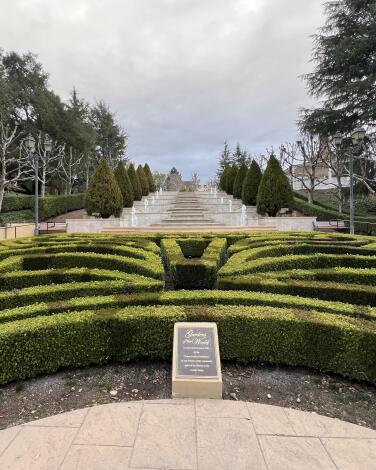
Follow the circular walk in this 4.5-acre garden to visit a small Japanese garden, complete with an exquisite pagoda, koi pond, bamboo grove, bonsai trees and a waterfall. Further along is a California mission-style courtyard with murals honoring the state’s missions and a three-tier fountain, which in the 18th century was designed to provide water for chickens at the bottom, horses at the mid-level and humans at the top!
Further along are carefully tended box hedges and a huge cascading fountain reminiscent of the fountain at Versailles outside Paris — it’s the first thing you see if you enter the garden on foot through the massive iron gate on the street. Further along is a traditional English garden lined with carefully trimmed hedges filled with roses and flowering perennials and then an Italian garden with a grape arbor and a chain fountain flanked by towering cypress. In the center of all this is a large, white “traditional American bandstand,” where the philanthropic Hogan Family Foundation, the garden’s owners, sometimes schedule concerts.
A brisk walker can complete the loop in 15 to 20 minutes. There are also picnic tables shaded in summer by stately London plane trees, where visitors can bring prepared food to eat amid the splendor, but only at the picnic tables and bandstand lawn areas. A reminder that this is not a public park but a privately owned garden whose benevolent owners open its gates to the public five days a week.
Admission: Free. On-site parking is limited but also available for free, or you can park on the street outside. The garden offers free, 45-minute docent-led tours Tuesdays through Fridays, for those who call ahead to make a reservation.
Hours: Tuesdays through Saturdays, 9 a.m. to 5 p.m. (last entry at 4:30 p.m.) Closed Sundays and Mondays.
Food: Prepared food is allowed only at the picnic tables and bandstand lawn areas.
Other: The wide perimeter paths are wheelchair-accessible. No pets permitted. Restrooms are available near the entrance.
Japanese Friendship Garden & Museum

I expected a compact little garden, but once you’re inside the paths cover 12 sloping acres of lushly landscaped paths laced with koi ponds, flowing water, bonsai, sculptures and 200 cherry trees, specially bred to reliably bloom in San Diego’s mild coastal climate. The garden opened in 1991 as an expression of friendship between San Diego and its Japanese sister city, Yokohama, and features plants native to Japan and San Diego.
Spring is one of the most colorful times to visit, when many of the trees and shrubs are in bloom, but it’s still a serene place to wander during the rest of the year. There is nothing wild about these carefully groomed gardens, but there are a few moments of spontaneity, such as the lazily watchful sentry cats at the entrance and the chameleon-like anole lizards that change from bright green to dusty brown as they cling to the trees. One regular visitor told me he’s watched people admiring plants without realizing the lizards are just inches away from their noses.
Bottom line: This garden is a lovely place for long contemplative walks, although most visitors are funneled along the same paths. There’s only one way in and out so if it’s crowded, you’ll pass many people walking up and down the sloping trail.
Admission: Tickets are $16 or $14 for ages 7-17, seniors 65+ and military personnel; children 6 and younger enter free.
Hours: 10 a.m. to 7 p.m. daily (last entry at 6 p.m.)
Food: No outside food or water is permitted in the garden, but you can purchase food at the Tea House restaurant at the entrance.
Other: Only ADA service animals are allowed in the garden. Most of the paths are wheelchair-accessible, but the lovely lower garden is at the bottom of a winding hill so expect a climb coming back.
Los Angeles County Arboretum & Botanic Garden
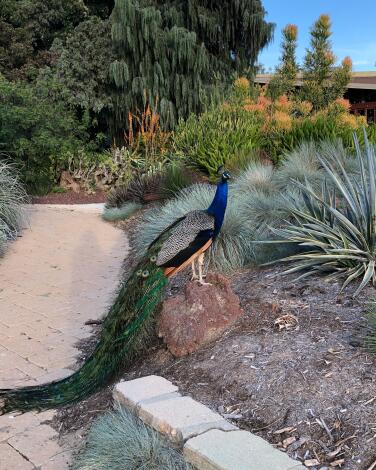
Regardless, there’s nothing stuffy about the arboretum, and plenty of beautiful places to wander, such as the aquatic gardens that include the Meyberg Waterfall, the Meadowbrook Garden (filled with deciduous trees whose colorful blooms and leaves change every season against a tapestry of evergreens) and the tropical greenhouse with thousands of orchids.
Of course, there are the standard botanic garden plantings grouped by geography — South American, Mediterranean, South African, Australian and Asiatic-North American. But the arboretum also has extraordinary demonstration gardens such as the Crescent Farm, a onetime compacted lawn transformed into a lush, drought-resistant garden of California native plants and low-water fruits, vegetables, ground covers and shrubs by using lasagna mulching and hugelkultur beds to rebuild the soil.
Peacocks nonchalantly roam throughout — they’re descendants of the three birds imported by Rancho Santa Anita’s last owner, Elias Jackson “Lucky” Baldwin. There are historic buildings as well, such as the relocated Santa Anita Depot and the Queen Anne Cottage built by Baldwin. Little-known fact: This garden is also a great place for botanic research, thanks to its extensive library that you can search online and staff like Frank McDonough, a full-time botanical information consultant whose job is to answer the public’s questions about plants. (Call McDonough at [626] 821-3236.)
The garden offers a range of regular classes such as forest bathing, guided bird walks and goat yoga and provides space for many plant-related conventions and clubs. It also offers $8 tram tours Wednesdays through Sundays and a charming, well-stocked gift shop. It’s truly a garden for the masses, especially if they have a taste for wonder.
Admission: $15, $11 seniors 62+ and students with ID, $5 ages 5-12, members and children 4 and younger enter free. Free days are the third Tuesday of the month for people who are able to reserve a ticket on the first of each month.
Hours: Open 9 a.m. to 7 p.m. daily. Members can enter as early as 7:30 a.m.
Food: The Peacock Café is open daily from 9 a.m. to 4 p.m. on weekdays, and 4:30 p.m. on Saturdays and Sundays.
Other: No pets permitted except trained service dogs. Most of the arboretum’s wide paths are wheelchair-accessible.
Moorten Botanical Garden
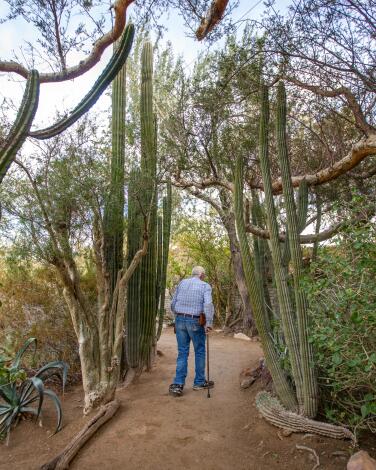
This quirky, endearing garden is one of the last remnants of old Palm Springs, when there was time to watch little birds flit fearlessly among the thorns, marvel at a palm that grows sideways about 8 feet before it grows up and listen spellbound to Moorten’s wonderful and seemingly endless stories.
The garden itself is small — roughly an acre of mature, artfully arranged cactuses and desert plants along shady dirt paths with hand-lettered signs, decaying desert artifacts and the famous “cactarium,” a word invented by Moorten’s mother, Patricia, who with his father, Chester “Slim” Moorten, began expanding the garden, established in 1938, after they bought the property in 1955.
The cactarium, by the way, is a small weathered Quonset hut stuffed with weird and rare cactuses — some of which wind along the ground like snakes or grow upside down from their pot like a prickly stalactite.
There’s a nursery here too, for people who want to take some plants home. This is a garden visitors can easily traverse in a few minutes, but honestly you’ll want to give yourself time to sit on a bench, browse in the nursery, and, if he’s around, listen to at least a few of Moorten’s stories about old Palm Springs and his remarkable parents. His father, for instance, was a logger as a teenager, who hitchhiked to Hollywood in the 1920s to become a Keystone Kop, then moved to the desert to fight off tuberculosis where he discovered that raising cactus paid better than gold mining — especially when Walt Disney asked him to suggest plants for “a little amusement park” he was creating in Anaheim, and he ended up supplying the plants for Frontier Land.
Moorten, 82, was an only child, and he still talks about his parents as though they’ll walk around the corner at any moment. “I was born with stickers in my butt,” he says on the website, and enough memories and stories to make this endearing garden glow.
Hours: Depends on the season. Between Oct. 1 and May 31, the garden is open every day but Wednesdays from 10 a.m. to 4 p.m. In the summer, June 1-Sept. 30, when the heat is at its fiercest, the garden is open Fridays through Sundays only, from 9 a.m. to 1 p.m.
Admission: $7 adults and seniors; $5 veterans, $3 children 5-12. Children under 5 enter free.
Food: No food is sold at the garden, but there is a drinking fountain and they sell bottled water at the entrance. There are tables where visitors can bring prepared food into the garden to eat.
Other: There are restrooms at the back of the garden. The garden trails are compact dirt and wide enough to accommodate wheel chairs, but the cactarium’s narrow aisles and steps are not wheelchair-accessible.
Niguel Botanical Preserve

Boy, was I wrong. Niguel Botanical Preserve is a hilly 18-acre oasis laced with paths leading to flora from the world’s five Mediterranean climate regions: “California and Northwestern Baja California, Central Chile, southern and southwestern Australia, the West Cape of South Africa and countries bordering the Mediterranean Sea,” plus a lovely rose garden with many fragrant David Austin English roses, a formal garden complete with labyrinth and gazebo, groves honoring Girl Scouts and Laguna Niguel’s Citizens of Year, and the sometimes challenging Trail to Eagle honoring the Boy Scouts and the many steps to Eagle Scout status.
This is a terrific place to get your steps in while exploring a huge range of plants and trees. The preserve boasts having one of the nation’s largest collection of Mediterranean-climate plants from Chile along with meadows of California native grasses, groves of native oaks and the Dr. Seuss-type plants of Australia and South Africa.
Admission: Free
Hours: Open daily, sunrise to sunset
Food: No food is sold at the garden, but there are drinking fountains and ample restrooms in the parking area and picnic tables in the adjoining park.
Other: The lower paths are wheelchair-accessible, especially to the formal garden and rose garden, but many other paths are not. Dogs are permitted on leash.
Point Loma Native Plant Garden

Admission is free, and there are about a mile of (mostly) well-maintained looping trails through the 2.5-acre garden, which include many Southern California regulars in the native plant world (toyon, Matilija poppy, sages, ceanothus, elderberry trees and coast live oaks) as well as plants specific to the nearby San Diego River estuary, such as willowy monardella (Monardella viminea), a.k.a San Diego willowy mint, a rare purple-flowered perennial that only grows in San Diego County.
It’s part of the city of San Diego’s Collier Park West, between Ocean Beach and Point Loma, but the main entry gate is in a residential area at the corner of Mendocino Boulevard and Greene Street in Ocean Beach. My GPS wound me through lots of charming residential streets until we arrived at the unprepossessing entrance nearly obscured by surrounding homes. The only parking is on the street, but we found a nearby spot easily on a Saturday.
The gate is unattended, but once inside there are plenty of explanatory signs, a little library where visitors can help themselves to free packets of seeds collected from garden plants, and encouragement to come back as a volunteer to work in the garden.
Hours: Open daily, from sunrise to sunset.
Admission: Free
Food: No food is sold at the garden, but there are plenty of benches and a few picnic tables for people who want to enjoy a meal or just sit and savor; just be sure to carry out your trash.
Other: Dogs are permitted if they (and their people) stay on the trails. The upper paths near the entrance are smooth enough for wheelchairs but further into the garden the paths get narrower and rocky in places. There are no restrooms.
San Diego Botanic Garden
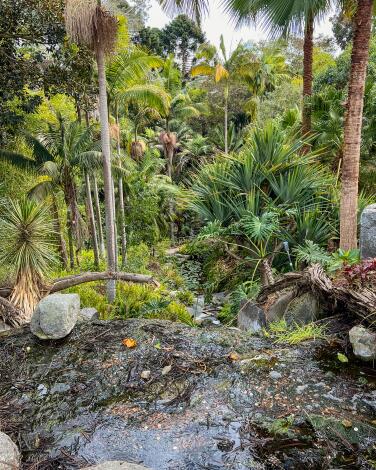
The children’s garden is pretty terrific, with Toni’s Tree House, a huge human-made tree draped in living plants that’s accessible to at least a dozen little ones at once from multiple levels. They can scale it by rope or climb up stairs to a bridge or forage among its roots, and when they’re tired of the tree there’s a tiny stream to wade in or a steepish path to wander to reach the garden’s Overlook Tower, where you can see an expanse of native shrubs to the east, the lush tree tops in the tropical jungle to the south and the Pacific Ocean to the west.
Of course, there are many plants to love as well spread through its 37 acres, with flora from Mexico, South America and South Africa, enhanced with waterfalls and streams that give way to desert environs. If you want to feel like an ant walking through stiff grass, visit the towering bamboo garden, purported to be North America’s largest public bamboo collection. There are also demonstration gardens devoted to such things as fire-safe landscapes, edible landscapes (see real bananas growing on real trees!) and the practices of the area’s Indigenous Kumeyaay people.
Admission: Tickets are $18 ($15 for military, students and seniors 60+, $10 for children ages 3-17, and free to children under 3 and members.) Cash is not accepted.
Hours: Open six days a week (closed on Tuesdays, Thanksgiving day and Christmas day) from 9 a.m. to 5 p.m.
Food: Light snacks, coffee and other beverages are available for purchase; visitors can also bring food and nonalcoholic drinks in during regular hours.
Other: A few wheelchairs are available for free, on a first come, first served basis. No pets are permitted except trained service animals.
Santa Barbara Botanic Garden

Be sure to descend to the floor of the redwood grove, just to be inspired by its quiet grandeur. Then follow Mission Creek south to explore the aqueduct. Check out the maze in the children’s garden, and cross the creek to climb up to the manzanita garden, which features 60 varieties of the red-barked plants, ranging from sculptural ground covers to midsize shrubs and small trees — all of which have delicate bell-shaped blooms in the spring. This garden is a good way to see how California native plants can be incorporated into residential spaces. There’s also a water-wise home garden with useful suggestions about how to landscape using drought-tolerant native plants and a nursery where you can purchase at least some of the plants you admired. For die-hard horticultural researchers, the garden’s Blaksley Library, established in 1927, includes more than 15,000 books, journals and digital media about California’s plants and landscape history, as well as an extensive photo collection.
Admission: $20, $16 seniors 60+ and military, $14 students with ID, $12 children ages 3-12, free entry to members and children under 3. Reservations are required for nonmembers and strongly recommended for members due to the capacity limits, and include parking for one car.
Hours: 10 a.m. to 5 p.m. daily. Members can enter at 9 a.m.
Food: There is a gift store but food is not available for purchase; carry-in food is permitted.
Other: Only some parts of the garden are wheelchair-accessible, mostly in the upper levels. Dogs are permitted if leashed. Restrooms are located near the entrance.
Sherman Library & Gardens
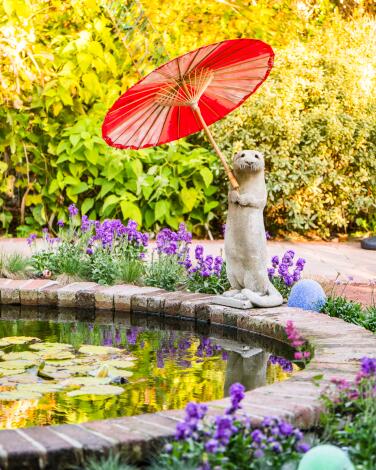
Sherman Gardens often weaves classes and art among its plants, hosting sculpture installations, seasonal light displays and performances by a contemporary dance troupe. The library specializes in the history of the Pacific Southwest, including Southern California, Arizona and northern Mexico, with 15,000 books and a collection of California Impressionist art. It’s easy to spend a few hours in this small garden. Maybe that’s because its intimacy and easy access invite you to linger and savor what you see.
Admission: $5; members and children 3 and younger enter free.
Hours: Open 10:30 a.m. to 4 p.m. daily except Jan. 1, July 4, Thanksgiving day and Dec. 25.
Food: The garden’s restaurant, 608 Dahlia, is open from 11 a.m. to 2 p.m. Wednesdays through Sundays.
Other: No pets permitted except trained service dogs. The level paths are wheelchair-accessible and the designated entry for wheelchair users is off Pacific Coast Highway next to the gift store.
South Coast Botanic Garden
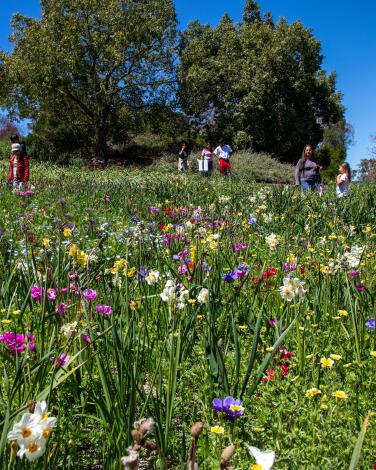
All in all, the garden has more than 2,500 species of plants and five miles of trails, but if that feels overwhelming, the garden’s website offers a downloadable map for easy planning, along with suggestions for what to see based on how much time you have to visit. The garden also has popular seasonal events that require an additional fee such as Soar, its butterfly pavilion and garden.
If you only have 45 minutes, you can still see a lot at this garden with brisk walking, but if you’ve got the time it’s an easy, fragrant place to while away an entire afternoon. Just remember to bring something to eat and drink on weekdays!
Hours: Open 8 a.m. to 5 p.m. daily except Dec. 25.
Admission: Reserved tickets required for nonmembers; members must reserve tickets on Saturdays and Sundays, free days and holidays. Tickets are $15, $11 seniors 62+ and students, $5 children ages 5-12, free for members and children 4 and younger. Free admission with reservations on the third Tuesday of each month.
Food: Dottie’s at the Koi Pond sells food, beer, wine and specialty cocktails on Saturdays and Sundays only from 10:30 a.m. to 4:30 p.m. Carry-in food is permitted if pre-prepared.
Other: Leashed dogs are permitted only during designated dog walking hours, typically scheduled the last Sunday of every month, otherwise pets are not permitted on site.
Storrier Stearns Japanese Gardens
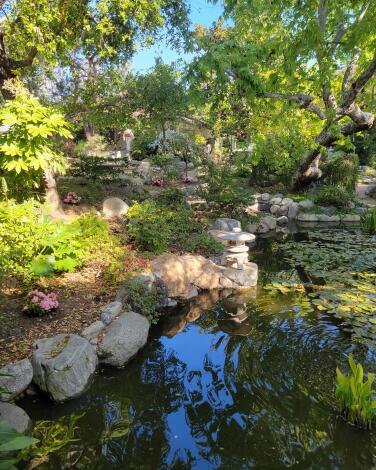
This privately-owned nonprofit garden has limited hours. But if you’re looking for a special evening out on Friday or Saturday, grab your favorite takeout and even a bottle of wine and watch the day melt into night, with strings of lights reflecting off the pond. The teahouse is lighted but no longer open to visitors except during special events. “People were coming and doing yoga in there,” said site manager Heidi Ferraro, “so now it’s only open for tea ceremonies.”
Admission: Tickets are $15 on Fridays and Saturdays and $12 on Sundays for people 13 and older. People 12 and younger enter free.
Hours: Open 4 to 8 p.m. Fridays and Saturdays, unless the garden is rented for a special event, and 10 a.m. to 4 p.m. Sundays. Note that hours vary based on the season and site rentals, so be sure to check the website before you go. Shorter hours happen in the winter after daylight saving time.
Food: No food is sold at the garden, but you can bring your own food and drink. Be sure to bring your own cups, bottle openers, cutlery and plates and take it all out with you when you leave.
Other: Most of the garden is wheelchair-accessible. Pets are not permitted.
SuihoEn — The Japanese Garden
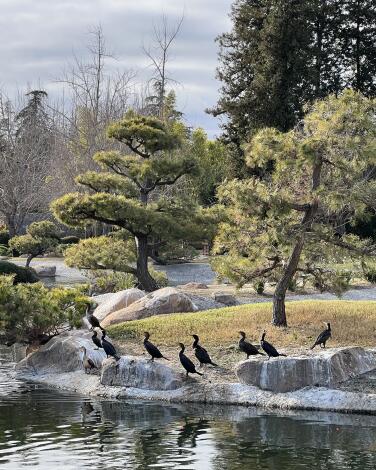
Don’t recoil. This 6.5-acre garden designed by landscape architect and artist Koichi Kawana is unusual, and, to be honest, a little too perfect for my taste, but for bird watchers or artists or anyone who enjoys rolling vistas along glimmering water, this is definitely a place worth visiting. For one thing, parking and admission are free. For another, it’s only open at odd times on weekdays and closed for lunch, so you won’t be fighting a crowd. And it’s not often you see a walk that includes a dry Zen meditation garden with a three-Buddha stone arrangement and wisteria arbor, a “wet-strolling” garden with waterfalls and streams and a 4.5 tatami-mat teahouse with adjoining tea garden.
One note, however — while the setting looks serene, its proximity to the Van Nuys Airport means you can’t enjoy much silence because the sound of aircraft and thumping helicopters is pretty much incessant. The garden’s entrance gate can sometimes be closed, but there is someone at the gate who can open it for visitors as long as you are visiting during the rather limited hours, so persevere. Once inside the gate, there is plenty of free parking.
Still, this garden is worth a visit just because it’s so unique; a kind of testament to the optimism and tenacity of humans who, with a lot of effort and ingenuity, have made something beautiful out of the yucky stuff we flush down our toilets every day. The garden is circular, and a brisk walker can make the circuit in less than 30 minutes, but I saw several people just sitting and watching the wildlife before them, mostly gangs of ducks, cormorants and other water birds who have made the garden their home. When we visited in February, star magnolia trees were just starting to bloom with floppy, white-petaled flowers, providing pops of shine against the deep green conifers and shrubs.
Admission: Free
Hours: Mondays-Thursdays, 9:30 a.m. to noon and 1 to 3:30 p.m. (closed from noon to 1 p.m. for lunch and Fridays-Sundays.
Food: No food or beverage is permitted in the garden except bottled water.
Other: Dogs and other pets are not permitted in the garden. The paths are wheelchair-accessible. Restrooms are available at the entrance.
Taft Gardens & Nature Preserve

Wear good walking shoes. The paths can be uneven in spots, but there aren’t any serious climbs here — just a good wander through towering bottle trees and succulents and a riot of colorful blooms, especially in the spring. Water and restrooms are available toward the back of the gardens near the event center, but the managers suggest bringing your own pack-in-and-pack-out picnic along with extra water — especially in the heat. There are several worthy places to buy food in nearby Ojai. Order ahead and pick it up on your way to the gardens. This trip will take some planning, but once you get there you’ll feel like you have the place all to yourself. That kind of intimacy in a beautiful SoCal garden is a rare treat.
Admission: $20, children 12 and younger enter free. Tickets must be purchased online at least 24 hours in advance; no same-day tickets are available.
Hours: Vary by season so check the website. Currently timed-entry tickets are available Tuesdays through Saturdays at 11 a.m. and 1 p.m.
Food: No food is sold on-site, but water and restrooms are available. Carry-in food is permitted.
Other: Dogs are permitted if leashed. Most garden paths are gravel or mulch, so wheelchair access can be limited in places. Call ahead for more information about accessibility.
The Getty Center Gardens
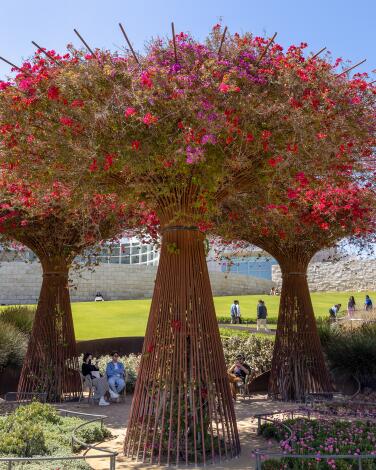
Brilliant bougainvillea cascade out of tall iron trellises like colorful giant umbrellas, and the foliage and plantings change with the seasons to live up to Irwin’s statement about the garden: “Always changing, never twice the same,” carved into one of the stepping stones.
The gardens also include a variety of cactuses, succulents and sculptures, all framed by the Getty’s austere, otherworldly architecture.
Admission: Free, but parking is $25 per vehicle or $15 after 3 p.m. and $10 after 6 p.m. (Starting June 2, parking will be free after 6 p.m. on Saturdays.) Free garden tours are conducted a few times a day, based on docent availability. Check at the information desk at the main entry hall for times that day.
Hours: 10 a.m. to 5:30 p.m. Sundays-Fridays, 10 a.m. to 8 p.m. on Saturdays. Closed Mondays and Jan. 1, July 4, Thanksgiving day and Dec. 25.
Food: Available for purchase at a cafe, restaurant and two coffee carts.
Other: No pets permitted except trained service dogs. The garden paths are all wheelchair-accessible.
The Huntington

But the main event here is the Huntington’s 130-acre gardens, a sprawling collection of extraordinary roses, exquisite Chinese and Japanese gardens, and areas dedicated to Australian plants, Shakespearean plants, herbs, desert plants, jungle and subtropical plants (you can almost hear Tarzan bellowing somewhere in those towering, vine-dripping trees) and, of course, a whimsical garden to enchant children.
If you want a free-day ticket (the first Thursday of every month), you’ll need to be strategic, ready to jump on a reservation at 9 a.m. the Thursday before. Due to the huge demand, people are assigned a random number after they enter the online waiting room for free tickets. If your number is selected, you can receive up to five tickets per household (babies also need tickets on free days).
Admission: Tickets are $29 ($24 for seniors 65+, military with ID and students 12-18 or full-time with ID; $13 for ages 4-11 and free for children under 4 and members). People with SNAP EBT cards can enter for $3 under the Museums for All program. Note that members are not permitted on free days. Free garden tours are available (except on free days) at 10:30, 11 and 11:30 a.m. subject to docent availability.
Hours: Open from 10 a.m. to 5 p.m. daily except Tuesdays, reservations are required Friday-Sunday and during “peak season” times. Bottom line: It’s safest to make reservations no matter what day you plan to visit. Note the new Japanese Heritage Shōya House is only open from noon to 4 p.m. Closed July 4, Thanksgiving and Dec. 24-25.
Food: The food options are varied and very good. The Jade Court Cafe in the Chinese Garden offers a range of yummy cuisine, plus beer and wine. There’s also the renovated and popular Rose Garden Tea Room as well as the 1919 Cafe near the entrance and the Red Car coffee shop for grab-and-go coffees, ice cream cones and sandwiches — along with indoor and outdoor seating.
Other: No pets permitted except trained service dogs. Most gardens are wheelchair-accessible, and wheelchairs are available for loan on a first-come, first-served basis. A visitor shuttle travels in a counterclockwise loop through the gardens between 10 a.m. and 5 p.m., making eight stops around the grounds at locations listed on the visitor map.
The Nature Gardens at the Natural History Museum of Los Angeles County
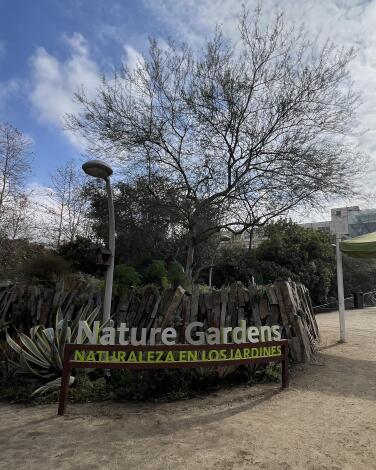
At the entrance a living wall of giant sandstone splinters curves into the garden, acting as fence and planter. The top is filled with succulents, Mediterranean-climate plants and many California native flowers, perennials and shrubs, and the sides are laced with more plants sprouting from the rocks, providing homes to insects and lizards.
The 3.5 acre garden opened in 2013, and one of its primary goals was to provide habitat for urban wildlife, especially birds and pollinators. The Sarah Meeker Jensen Pond is alive with thirsty birds, dragonflies and even Arroyo chub, the little native fish that once thrived in the Los Angeles River. There’s also a small “urban waterfall,” and a broad shallow creek where children can wade on hot days and a wildlife viewing platform for birds and other creatures, dotted with feeders, bee “hotels” and plenty of nectar providing flowers.
Further in, you’ll find the Erika J. Glazer Family Edible Garden, where beautifully tended raised beds grow a large assortment of delicious-looking produce. If your children (or you) aren’t sure where vegetables come from, here’s a chance to discover up close how plant food is grown.
The museum offers guided tours of the garden (free with museum admission) from 11 a.m. to noon most Saturdays and Sundays, and there’s a “Get Dirty Garden,” where children can balance on a path of logs and tree stumps, search for insects in compost piles and explore a house made from willow branches.
Finally, next door to the nature gardens outside the California Science Center is the the Exposition Park Rose Garden, billed as the country’s largest when it opened in 1927, according to a PBS report. It opened with more than 100 species of roses and by 1949, reportedly boasted 150 species and some 15,000 roses in all. It’s still an awe-inspiring sight, but you’ll want to visit after April when the roses start blooming, because the pruning in the winter leaves the bushes bare.
Admission: Visitors can tour the Nature Gardens with a ticket to the Natural History Museum; $18, or $14 for seniors 62+ and students with ID, ages 13-17, $7 for ages 3-12 and free for members and children under 2. Los Angeles County residents can also visit the museum for free Mondays through Fridays between 3 and 5 p.m. Admission to the Exposition Park Rose Garden is free.
Hours: Open 9:30 a.m. to 5 p.m. daily, except the first Tuesday of every month, Jan. 1, July 4, Thanksgiving day and Dec. 25. Exposition Park. Rose Garden is open daily, 8:30 a.m. to dusk.
Food: You can purchase food at the Natural History Museum and the California Science Center next door.
Other: Restrooms are available at the museum. The gardens are wheelchair-accessible and visitors can borrow wheelchairs from the museum on a first-come, first-served basis.
UC Riverside Botanic Gardens

The garden also has collections from a variety of geographical areas, including Australia and South Africa, as well as the eastern United States, with its temperate deciduous forests and North American deserts. And, of course, it also covers regions of California, from Baja and the California chaparral to North Coast redwood forests, oak woodlands, coastal sage scrub — native to the hills where the gardens are located — and a lovely shady area known as Alder Canyon full of native California riparian trees.
You could see plenty of wildlife too, including migrating birds, rattlesnakes, coyotes, bobcats and even the occasional mountain lion according to the staff, so walk with care.
Admission: No charge but suggested $5 donation, which can be offered via QR code or with cash at the gate. Parking is $2 an hour at the garden’s small parking lot, maximum of three hours, or $3.50 an hour, maximum two hours, in Lot 10 a bit farther away. And farther on, free parking options are available on weekends in Lot 13.
Hours: 8 a.m. to 3:30 p.m. Monday-Friday plus the first and third Sundays of every month from 8 a.m. to 2 p.m. (last entry half-hour before closing). The garden is closed on major holidays or when the campus is closed for academic and administrative holidays. The campus calendar is here.
Food: Food is not available for purchase in the garden, but it’s permissible to bring prepared foods into the garden.
Other: Pets are not permitted. Water and restrooms are available near the entrance. The garden has a gentle paved switchback trail available from the lower garden up to the rose garden and pond areas for wheelchair users and stroller pushers.
UCLA Mildred E. Mathias Botanical Garden
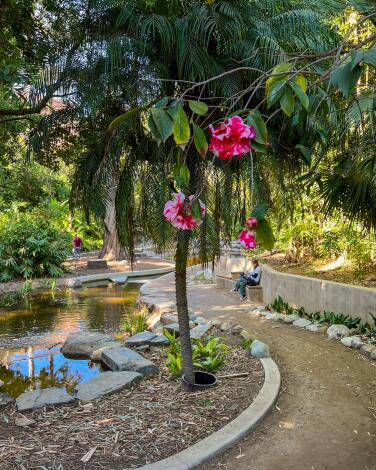
The garden that opened in 1929 is named after famed botanist Mildred E. Mathias Hassler, one of UCLA’s first female professors and the garden director from 1956 to 1974. It now features more than 3,000 plant species from around the world, with sections ranging from ancient forests, conifers, ferns and palms to native plants from California and Hawaii.
There’s even a weird and prickly porcupine tomato (Solanum pyracanthum) that hails from Madagascar with star-shaped purple flowers and narrow serrated leaves sprouting long, orange spikes, which should give any would-be harvesters pause since the small dark fruit is poisonous, along with the rest of the plant. The website includes a month-to-month list of what’s blooming and free, self-guided audio tours for each part of the garden.
Early this year, UCLA completed a major stream revitalization project for the garden to stop the huge loss of water — the equivalent of 200 swimming pools worth of water per year, according to the website. Now the garden has a new rainfall collection pond, improved irrigation system and multitiered waterfall to accompany the recirculating stream and ponds that run the length of this serene, dappled property. Handsome wooden benches, chairs and tables are scattered throughout, providing opportunities for group discussions over lunch or just places to sit quietly alone.
Massive trees tower over many of the paths, and it takes a lot of neck craning to see their tops. I got dizzy trying to see the top of a breathtaking rose gum eucalyptus, notable for its massive height and smooth, milk-white trunk and limbs. Another, billed as one of the largest torrey pines in the world, has somehow split into two trees halfway up. Insolent, well-fed squirrels stare unconcerned at the humans wandering through their forest, and honestly, it felt as though there was room here for everyone, even though it was lunchtime and many people were walking through. When you visit — and you must, at least once — bring a lunch so you can sit and savor the sights around you. You could visit daily and still find something new and wonderful to see every time.
Admission: Free, but if you drive, parking costs $4 an hour, or $16 a day. You can find metered parking along the street, as well as parking in Parking Structure 2 and Parking Lot E. The Metro, Culver City and Santa Monica buses have stops near the garden. Free guided tours are typically held the first Saturday of the month, starting at the La Kretz Garden Pavilion.
Hours: 8 a.m. to 5 p.m. weekdays, 9 a.m. to 5 p.m. Saturdays and Sundays, except during November through January, when the garden closes at 4 p.m. Closed Thanksgiving day and Dec. 25, closes at 2 p.m. on Dec. 24 and Dec. 31.
Food: No food is sold at the garden, but there are tables and chairs where people can bring in food to eat.
Other: Restrooms are available near the main entrance in the La Kretz Garden Pavilion. Leashed dogs are permitted. Most of the paths are wheelchair-accessible.
Ventura Botanical Garden

New plantings began in 2018, and today the garden is 107 acres with more than 120,000 plants in place, including a young olive grove on one hill, rare Chilean wine palms that survived the fire despite the charring on their thick trunks and, in the South African Fynbos and Karoo gardens, proteas with blooms like fireworks, Dr. Seuss-like succulents and fragrant mounds of scented geraniums.
The gardens are devoted to the world’s five Mediterranean climate zones — central Chile, the Cape region of South Africa, Southwest Australia, California (including Baja) and, of course, the Mediterranean basin. The walks are uphill (unless you’re returning to the entrance), but the incline is so gradual and the view so inspiring that you hardly notice the climb.
This garden is really filling out as the plants mature and spread, but these lovely terraced gardens are as much about the heart-soaring vistas of Ventura’s curving coastline and ever-changing sky as they are about the plants along the trails.
Admission: $7, free to members and ages 18 and under. Admission is free on Fridays and select holidays. Free, docent-led garden tours are available by advance request.
Hours: Open 9 a.m. to 5 p.m. Tuesday to Sunday. Closed Mondays and on rainy days.
Food: Food is not sold on-site but can be consumed there.
Other: Leashed dogs are permitted on Wednesdays and Fridays. The gardens also have a small gift store and nursery at the entrance, along with bathrooms. Although the parking and main entrance areas are paved, the garden is hilly and the trails are mostly smooth dirt. Check at the entrance for wheelchair-accessible routes.
Wrigley Memorial & Botanic Garden

Wrigley’s remains were later moved to Forest Lawn cemetery in Glendale, but the memorial tower and 38-acre botanic garden are still there, with succulents, desert plants of the Americas and a large swath devoted to native plants endemic to the island — meaning they are only found natively on Catalina — along with plants endemic to the other Channel Islands. The garden is also the primary gateway to one of the Catalina Island Conservancy’s most popular hikes, the Garden to Sky trail.
Admission: $13.56; $11.39 seniors 55+ and students with ID, $8.14 ages 5-12, free to ages 4 and younger, Conservancy members and military members and family and veterans (with ID).
Hours: Open 8 a.m. to 5 p.m. daily except Thanksgiving day and Dec. 25.
Food: Carry-in food permitted on-site; water only available at the entrance.
Other: No pets permitted except trained service dogs.







